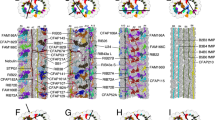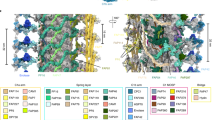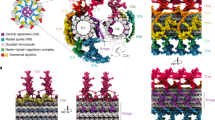Abstract
CALCIUM ions are probably a general regulator of the assembly state and function of most cytoplasmic microtubules, the organelles upon which processes such as cell division, transport and secretion, as well as ciliary motility, may finally depend. Ciliary activity is the best model we have of microtubule function and the cilium is the only microtubule-based system allowing extensive systematic dissection at present. We are therefore interested in the mechanism by which increasing cytoplasmic Ca2+ causes changes in ciliary beat parameters, particularly an arrest response in the mussel (Elliptio or Mytilus) gill1,2. It is well known that the beat in cilia is the result of a sliding interaction between doublet microtubules in the axoneme3,4, as can be demonstrated directly when axonemes are treated briefly with trypsin5. On addition of ATP the trypsin-treated axonemes no longer reactivate to beat normally; instead, they telescope apart. We demonstrate here that, although all sliding of the ciliary microtubules stops during ciliary arrest in vivo, the sliding interaction seen after trypsin treatment is not directly inhibited by Ca2+.
This is a preview of subscription content, access via your institution
Access options
Subscribe to this journal
Receive 51 print issues and online access
$199.00 per year
only $3.90 per issue
Buy this article
- Purchase on Springer Link
- Instant access to full article PDF
Prices may be subject to local taxes which are calculated during checkout
Similar content being viewed by others
References
Satir, P. Science 190, 586–588 (1975).
Takahashi, K. J. Fac. sci. Univ. Tokyo IV, 12, 219–228 (1971).
Satir, P. J. Cell Biol. 39, 77–94 (1968).
Sale, W. S. & Satir, P. Proc. natn. Acad. sci. U.S.A. 74, 2045–2049 (1977).
Summers, K. E. & Gibbons, I. R. Proc. natn. Acad. sci. U.S.A. 68, 3092–3096 (1971).
Walter, M. F. & Satir, P. J. Cell Biol. 79, 110–120 (1978).
Tsuchiya, T. Experentia 32, 1439–1440 (1976).
Schaffner, W. & Weissmann, C. Analyt. Biochem. 56, 502–514 (1973).
Gibbons, B. H. & Gibbons, I. R. J. Cell Biol. 63, 970–985 (1974).
Sale, W. S. thesis, Univ. California (1977).
Naitoh, Y. & Kaneko, H. Science 17, 523–524 (1972).
Summers, K. E. & Gibbons, I. R. J. Cell Biol. 58, 618–629 (1973).
Warner, F. D. & Satir, P. J. Cell Biol. 63, 35–63 (1974).
Witman, G., Fay, R. & Plummer, J. in Cell Motility (eds Goldman, R. et al.) 969–986 (Cold Spring Harbor Lab., New York, 1976).
Author information
Authors and Affiliations
Rights and permissions
About this article
Cite this article
WALTER, M., SATIR, P. Calcium does not inhibit active sliding of microtubules from mussel gill cilia. Nature 278, 69–70 (1979). https://doi.org/10.1038/278069a0
Received:
Accepted:
Issue Date:
DOI: https://doi.org/10.1038/278069a0
This article is cited by
-
Calcium sensors of ciliary outer arm dynein: functions and phylogenetic considerations for eukaryotic evolution
Cilia (2015)
-
Mechanical stimulation activates beating in calcium-arrested lateral cilia ofMytilus edulis gill
Journal of Muscle Research and Cell Motility (1986)
Comments
By submitting a comment you agree to abide by our Terms and Community Guidelines. If you find something abusive or that does not comply with our terms or guidelines please flag it as inappropriate.



